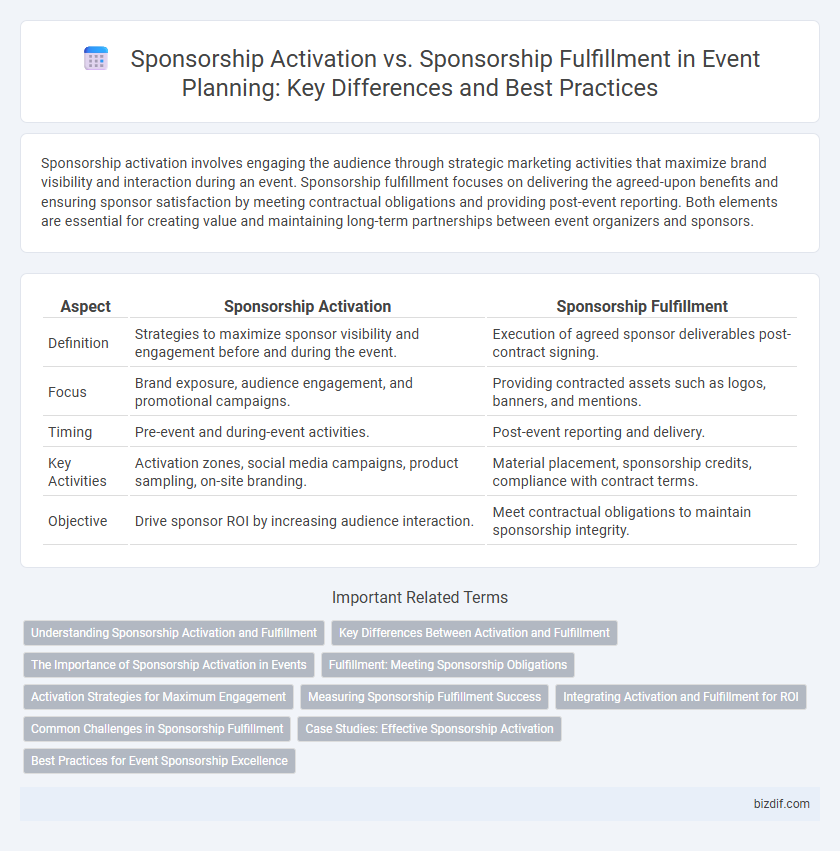Sponsorship activation involves engaging the audience through strategic marketing activities that maximize brand visibility and interaction during an event. Sponsorship fulfillment focuses on delivering the agreed-upon benefits and ensuring sponsor satisfaction by meeting contractual obligations and providing post-event reporting. Both elements are essential for creating value and maintaining long-term partnerships between event organizers and sponsors.
Table of Comparison
| Aspect | Sponsorship Activation | Sponsorship Fulfillment |
|---|---|---|
| Definition | Strategies to maximize sponsor visibility and engagement before and during the event. | Execution of agreed sponsor deliverables post-contract signing. |
| Focus | Brand exposure, audience engagement, and promotional campaigns. | Providing contracted assets such as logos, banners, and mentions. |
| Timing | Pre-event and during-event activities. | Post-event reporting and delivery. |
| Key Activities | Activation zones, social media campaigns, product sampling, on-site branding. | Material placement, sponsorship credits, compliance with contract terms. |
| Objective | Drive sponsor ROI by increasing audience interaction. | Meet contractual obligations to maintain sponsorship integrity. |
Understanding Sponsorship Activation and Fulfillment
Sponsorship activation involves strategically leveraging sponsor assets to engage audiences and create meaningful brand interactions, such as through experiential marketing, digital campaigns, and on-site promotions. Sponsorship fulfillment focuses on delivering the agreed-upon benefits outlined in the sponsorship contract, including brand visibility, logo placements, and media exposure metrics. Understanding the distinction ensures event planners maximize ROI by effectively activating sponsor partnerships while meeting contractual obligations.
Key Differences Between Activation and Fulfillment
Sponsorship activation involves strategic marketing efforts to engage audiences and create brand awareness during an event, leveraging interactive campaigns, on-site branding, and social media promotion. Sponsorship fulfillment focuses on meeting contractual obligations by delivering agreed-upon benefits such as logo placements, media exposure, and inventory distribution to sponsors. The key differences lie in activation's emphasis on real-time audience engagement and value creation, whereas fulfillment centers on compliance and delivering sponsor-defined assets.
The Importance of Sponsorship Activation in Events
Sponsorship activation in events maximizes brand engagement by creating interactive experiences that connect sponsors directly with target audiences, enhancing visibility and value beyond mere logo placement. Effective activation drives measurable ROI through strategic touchpoints such as experiential marketing, social media campaigns, and on-site activations, which foster deeper consumer connections. Prioritizing activation ensures sponsors achieve their marketing objectives, making it a critical component of successful event sponsorship strategies.
Fulfillment: Meeting Sponsorship Obligations
Sponsorship fulfillment involves executing all agreed-upon deliverables to meet contractual obligations and maximize sponsor satisfaction during an event. This includes delivering brand visibility, on-site activation support, and post-event reporting to demonstrate return on investment (ROI). Effective fulfillment ensures long-term partnerships by maintaining trust and enhancing sponsor value throughout the event lifecycle.
Activation Strategies for Maximum Engagement
Sponsorship activation strategies focus on creating interactive experiences that maximize audience engagement through tailored promotions, social media campaigns, and branded event elements that highlight the sponsor's core message. Effective activation integrates digital and on-site components such as live demonstrations, influencer partnerships, and exclusive giveaways to boost visibility and attendee participation. Measuring real-time engagement metrics and leveraging data analytics further enhances the impact, ensuring sponsors receive optimized returns on investment.
Measuring Sponsorship Fulfillment Success
Measuring sponsorship fulfillment success involves tracking key performance indicators such as brand visibility, audience engagement, and return on investment to ensure sponsors receive agreed-upon benefits. Detailed post-event reports analyze metrics like social media impressions, on-site activations, and lead generation to quantify fulfillment effectiveness. Accurate measurement supports optimizing future sponsorship agreements and improving collaboration between event planners and sponsors.
Integrating Activation and Fulfillment for ROI
Sponsorship activation involves strategic campaigns and onsite experiences that engage the target audience, while sponsorship fulfillment ensures contractual obligations, such as brand visibility and reporting, are met effectively. Integrating activation and fulfillment maximizes ROI by creating seamless interactions that amplify brand presence and provide measurable outcomes. Aligning creative activation tactics with fulfillment metrics drives stronger sponsorship value and long-term partnership growth.
Common Challenges in Sponsorship Fulfillment
Sponsorship fulfillment often faces challenges such as miscommunication between sponsors and event organizers, leading to unmet expectations and deliverables. Inadequate tracking and reporting mechanisms hinder transparent measurement of sponsorship ROI, reducing sponsor satisfaction and future partnership opportunities. Coordinating activations within tight event schedules frequently causes resource constraints and logistical issues, impacting overall sponsorship effectiveness.
Case Studies: Effective Sponsorship Activation
Case studies in event planning highlight that effective sponsorship activation drives brand engagement by creating immersive experiences tailored to target audiences, resulting in higher ROI compared to traditional sponsorship fulfillment, which primarily ensures contract compliance and brand exposure. Examples of successful activation include interactive booths, live product demonstrations, and exclusive attendee perks that deepen consumer connection and amplify sponsor visibility. Data from major events like the Olympics and music festivals illustrate that activation strategies increase sponsor recall by up to 70%, proving the critical value of innovative engagement over basic fulfillment.
Best Practices for Event Sponsorship Excellence
Sponsorship activation involves creating dynamic, engaging experiences that maximize brand visibility and audience interaction, while sponsorship fulfillment ensures contractual obligations are met with precise delivery and measurable results. Best practices for event sponsorship excellence include aligning activation strategies with sponsor goals, leveraging data-driven insights to enhance engagement, and maintaining transparent communication for seamless fulfillment. Effective collaboration between event planners and sponsors drives ROI, fostering long-term partnerships and elevating event impact.
Sponsorship activation vs Sponsorship fulfillment Infographic

 bizdif.com
bizdif.com